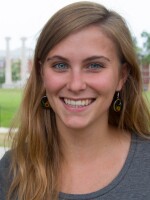Researchers from the University of Missouri are working with the Missouri Department of Conservation on a five-year study of white-tailed deer in the state. The study's goal is to find the survival differences of deer living in north east counties compared to south central counties.
The team of researchers are tracking the movements of deer using GPS collars in Nodaway, Gentry, Andrew, DeKalb, Wright, Texas, Douglas and Howell counties. Once the study is over, the Department of Conservation will use the data to reevaluate deer population management through strategies like hunting.
KBIA's Michaela Tucker spoke with Jon McRoberts, the project coordinator and wildlife researcher at the University of Missouri, about the progress of the study as it approaches the end of its first year.
Why is it important to reassess the deer population?
The white tailed deer is easily one of the most recognizable wildlife species in Missouri. It's one that occupies a lot of thought for wildlife watchers, white-tailed deer hunters, insurance companies with vehicle collisions, farmers. And so because of that and because the species means so much to so many groups out there, we need to be able to understand the ecology of the species to the best of our ability.
I know that you're using GPS collars on the deer, why was that an important aspect of this research?
Recently, the GPS technology became available. It's much more accurate, it's much more cost efficient. The collars we put on deer take a location every five hours. And so I can sit at my office in the university with a cup of coffee, after we get the collar on, that's the tricky part, and then receive those data remotely. We can get a precise location much more easily, accurately, and so it’s a game changer for wildlife research.
How did you get the GPS collars on the deer?
We use two methods, one's called a Clover Trap. And that's a netted, aluminum frame trap the deer will walk in to eat corn that we've baited the trap with, hit a trip wire and the door closes on them. That’s one method. The other way is something called a rocket net and this is an explosively propelled, 40 by 60 foot net and so we prepare a capture site and put a bait pile out and then set the net up and are in a ground blind near the net site, and we wait in the net when the deer come in and have their heads down eating, we can shoot the net. It’s a way to get multiple deer at one time. Using the Clover Trap or the rocket net, once we have a deer in hand, we'll blindfold it, we'll take morphometric measurements, we'll get the collar on, we'll take a tissue sample, we'll collect blood. And with our research crews, who became very experienced doing this, we could process a deer anywhere seven to ten minutes usually, sometimes even more quickly.
Now that deer-hunting season has started, what should hunters do if they see a deer with a GPS collar?
What we're encouraging hunters to do is not let the presence of the collar influence their decision to harvest that deer. One of our most important goals from this study is to be able to quantify annual survival of deer. And so, if that collar, if the presence of the collar, influences a hunter's decision to harvest or not harvest that deer, then it will bias our survival estimate. So the message we have to hunters is if you see a collared deer, and there are eight counties in the state where we have been collaring deer, don't let that presence of that collar influence your decision.
What will happen in the next year of the study?
We have two study sites. At each site, our goal is to have 90 deer, 90 adult deer, collared at one particular time. Our specific goals will change each year, depending on what carriers over from the previous years. But one thing's for sure, we'll be capturing deer each year of the project.




